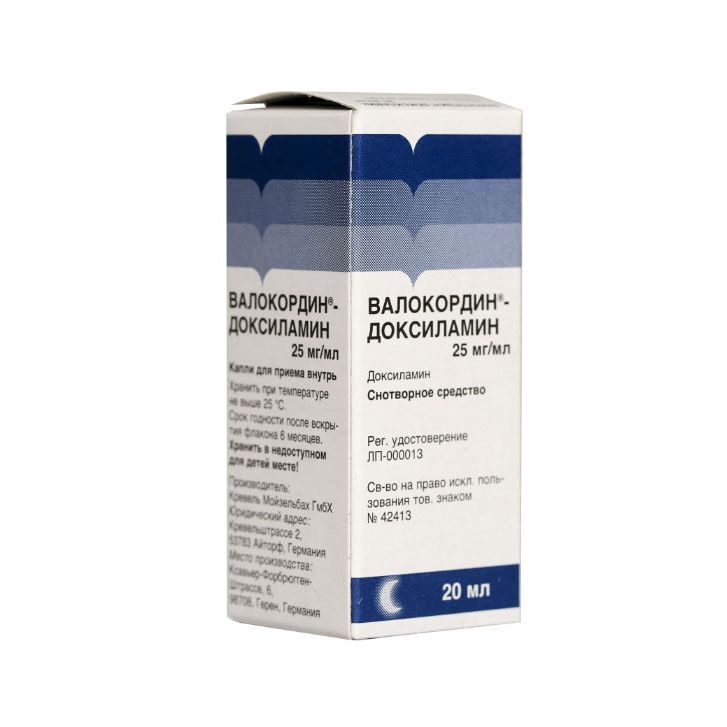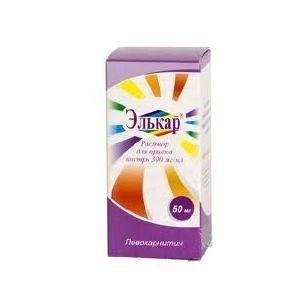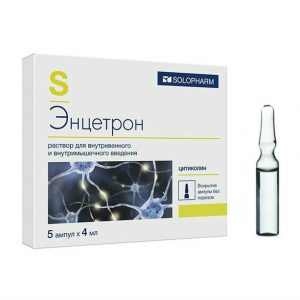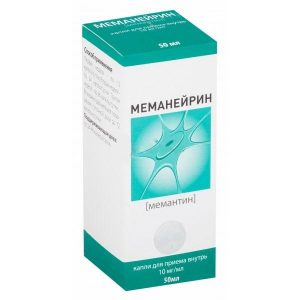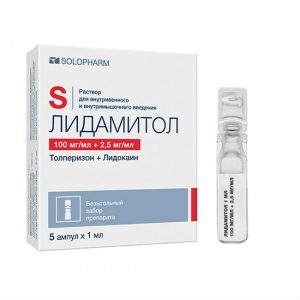Description
Release form
Drops for oral administration.
Packaging
Bottle 20 ml.
Pharmacological action
Pharmacodynamics
Blocker of H1-histamine receptors from the group of ethanolamines. The drug has hypnotic, sedative and m-anticholinergic effects. Reduces the time of falling asleep, increases the duration and quality of sleep, while not changing the phase of sleep.
Doxylamine is rapidly and almost completely absorbed immediately after oral administration. The action begins within 30 minutes, the maximum concentration in the blood serum of 99 ng / ml is detected 2.0-2.4 hours after oral administration of a dose of 25 mg. Duration of action is from 3 to 6 hours.
Pharmacokinetics
Mostly metabolized in the liver. It penetrates well through the histohematological barriers (including the blood-brain barrier). The elimination half-life ranges from 10.1 to 12 hours. The main part of the dose (approx. 60%) is excreted unchanged in the urine, partly in the intestine.
Indications
Symptomatic treatment of recurrent sleep disturbances (difficulty falling asleep and night awakenings) in adults.
Contraindications
Hypersensitivity to doxylamine and other components of the drug.
Angle-closure glaucoma.
Prostatic hyperplasia, urinary retention.
Children and teens.
Caution: pregnancy, liver disease, alcoholism, traumatic brain injury, or brain disease.
Use during pregnancy and lactation
Valocordin-Doxylamine can be used during pregnancy only when the intended benefit to the mother outweighs the potential risk to the fetus.
Breast-feeding should be discontinued during treatment, since the active substance is excreted in breast milk.
Special instructions
Valocordin-Doxylamine contains 55% vol. ethanol (alcohol), i.e. up to 900 mg per dose, which corresponds to 21, 87 ml of beer or 9.11 ml of wine per dose. It is dangerous for people with liver diseases, alcoholism, epilepsy, as well as for pregnant women and children.
Influence on the ability to drive vehicles and control mechanisms
Due to the possible drowsiness in the daytime, you should avoid driving, working with mechanisms and other activities that require quick mental and motor reactions.
Composition of
1 ml of the drug (22 drops) contains:
Active ingredient: doxylamine succinate – 25.0 mg.
Excipients: ethanol 96% – 450.0 mg, peppermint oil – 1.4 mg, purified water – 449.7 mg.
Dosage and Administration
For oral administration.
Drops should be taken with a sufficient amount of liquid (water) 30 minutes – 1 hour before bedtime.
Unless otherwise prescribed by a doctor, a single dose of Valocordin-Doxylamine for adults is 22 drops (which corresponds to 25.0 mg of doxylamine succinate). In case of serious sleep disturbances, the patient can take the maximum dose of the drug – 44 drops (which corresponds to 50, 0 mg doxylamine succinate).
The total daily dose should not exceed 44 drops.
It must be borne in mind that after taking Valocordin-Doxylamine, you should take care that you have enough time to sleep to avoid a delayed reaction the next morning.
Use in special patient groups
Patients with renal and hepatic insufficiency
Due to data on an increase in plasma concentration and a decrease in plasma clearance of doxylamine, dose adjustment is recommended to decrease.
Use in patients older than 65
H1-histamine receptor blockers should be used with caution in this group of patients due to possible dizziness and delayed reactions with the danger of falling (for example, during night awakenings after taking sleeping pills).
Duration of taking
In acute sleep disorders, if possible it should be limited to a single use. In order to verify the need for continued treatment with periodic sleep disorders, it is necessary to gradually reduce the dose no later than 14 days after the start of daily use.
Side effects
The frequency of side effects is given in accordance with the following scale:
Very frequent – 1/10 (> 10%).
Frequent – 1/100 appointments (> 1% and <10%). Infrequent – 1/1000 appointments (> 0.1% and <1%). Rare – 1/10000 appointments (> 0.01% and <0.1%). Very rare – less than 1/10000 appointments (<0.01%). The most commonly reported side effects are constipation, dry mouth, accommodation disturbances, urinary retention, daytime drowsiness (in this case, the dose should be reduced). Less commonly (from 0.01% to 10%) probable: Cardiovascular system: tachycardia, cardiac arrhythmias, decreased or increased blood pressure, and decompensation of an existing heart rhythm disorder may occur. Possible changes on the ECG. Hematopoietic system and lymphatic system: in extremely rare cases, after the use of antihistamines, changes in the blood picture in the form of leukopenia, thrombocytopenia and hemolytic anemia may appear, aplastic anemia and agranulocytosis are very rare. Nervous system: dizziness, headache. Vision disorders: increased intraocular pressure. Disorders of the ear and ear maze: tinnitus. Respiratory system: thickening of the bronchial secretion, bronchial obstruction and bronchospasm which can lead to impaired respiratory function. Gastrointestinal tract: nausea, vomiting, diarrhea, loss or increase in appetite, epigastric pain. In very rare cases, life-threatening paralytic intestinal obstruction may occur. Hepatic dysfunction (cholestatic jaundice) has been reported during therapy with H1-histamine receptor blockers. Urinary system: impaired urination. Skin: allergic skin reactions, photosensitivity disorders and thermoregulation may occur. Endocrine system: In patients with pheochromocytoma, taking antihistamines can increase the release of catecholamines. General disorders: nasal congestion, fatigue, muscle weakness. Mental disorders: undesirable effects that depend on individual sensitivity and dose taken include: delayed response, impaired concentration, low mood. In addition, there is a possibility of the appearance of so-called “paradoxical” reactions, such as anxiety,prostration, nightmares, confusion, hallucinations, tremors. After prolonged daily use against the background of a sudden withdrawal of therapy, sleep disturbances may intensify. Development of tolerance: after prolonged use of sedatives, a loss of effectiveness (tolerance) may occur. Dependence: Like taking other sedatives, taking Valocordin-Doxylamine can lead to the development of physical and mental dependence. The risk of dependence increases with increasing dose and duration of treatment and increases in patients with a history of alcohol, drug or drug dependence. Even with the end of short-term treatment with Valocordin-Doxylamine, temporary sleep disturbances may again occur due to sudden withdrawal. Therefore, it is recommended, if necessary, to complete the treatment, gradually reducing the dose. Anterograde amnesia: even at therapeutic doses, sedatives can provoke anterograde amnesia, especially in the first hours after administration. The risk increases with increasing dose, but can be reduced due to a sufficiently long continuous sleep (7-8 hours). Drug interaction With the simultaneous administration of the drug Valocordin-Doxylamine with antidepressants, barbiturates, benzodiazepines, clonidine, narcotic analgesics (analgesics, antitussive drugs), antipsychotics, anxiolytics, sedatives, 1 sedatives, sedatives central antihypertensive drugs, thalidomide, baclofen, pizotifenom inhibitory effect on the central nervous system. When taken with m-anticholinergic drugs (atropine, tricyclic antidepressants, antiparkinsonian drugs, atropine antispasmodics, disopyramids, phenothiazine antipsychotics), the risk of side effects such as urinary retention, constipation, and dry mouth increases. Since alcohol enhances the sedative effect of most H1-histamine receptor blockers, including and the drug Valocordin-Doxylamine, it is necessary to avoid the simultaneous use of alcoholic beverages and drugs containing alcohol. Overdose Symptoms: daytime drowsiness, dilation of the pupil (mydriasis), disorders of accommodation, dry mouth, redness of the face and neck (hyperemia), fever (hyperthermia), sinus tachycardia, disordered tachycardia, , disturbance of coordination of movements, trembling (tremor), involuntary movements (athetosis), convulsions (epileptic syndrome), coma. Involuntary movements are sometimes a harbinger of seizures, which can indicate a severe degree of poisoning. Even in the absence of seizures, severe doxylamine poisoning can cause the development of rhabdomyolysis, which is often accompanied by severe renal failure. In such cases, standard therapy with continuous monitoring of creatine phosphokinase activity is shown. If symptoms of poisoning appear, seek medical advice immediately. Treatment: symptomatic (m-cholinomimetics, etc.), activated carbon (50 g) is indicated as a first aid. Storage Conditions Do not store above 25 ° C. Keep out of the reach and sight of children. Shelf life 3 years. Shelf life after opening the bottle: 6 months. Deystvuyushtee substance doxylamine Dosage form drops for oral administration of Possible product names VALOKORDIN-DOXILAMIN 0.025 / ML 20ML FLAK / KAP Valocordin-Doxylamine 25 mg / ml drop 20 ml Drop-drop. X1 B VALOKORDIN-DOXYLAMINE DROPS 20ML Valocordin-Doxylamine drops 25 mg / ml, 20 ml VALOKORDIN-Doxylamine DROPS 25 mg / ML FL. 20ML Krevely Moyzelybah GmbH, Germany
